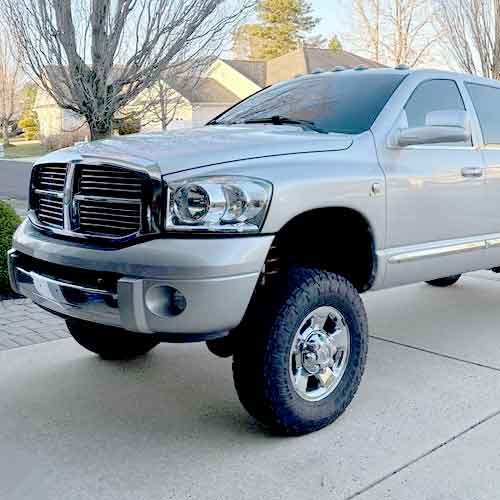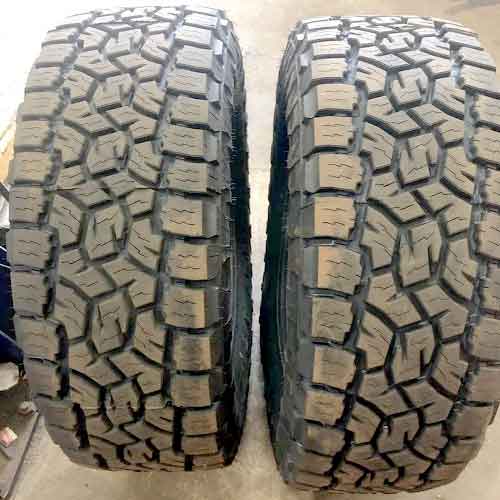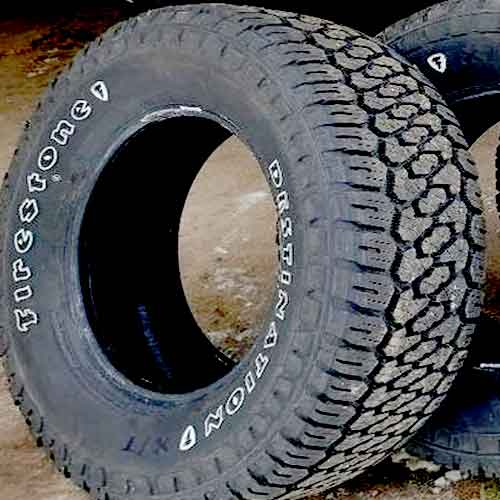Both the Firestone Destination X/T and the Toyo Open Country AT3 are marketed as all-terrain tires, the Destination X/T offers a better commercial traction in comparison, where it’s thermal adaptive rubber has better seasonal capabilities. Toyo AT3 on the other hand, gives you an all rounder daily driver.

Being a tire engineer from my perspective the Toyo Open Country AT3 provides you with better dry grip, though its really needs some wet traction. It’s supplies better noise dampening, wear resistance, and off road it shines on rocks. The Firestone Destination X/T, on the other side, offers better overall comfort, wet traction and fuel efficiency.
Firestone Destination XT (review) supplies sizes in 15 to 20 inches (wheel diameter). And they have following specs.
- Speed ratings: R and S.
- Load ratings: C and E.
- Weight Range: 35 to 60 lbs.
- Tread Depth Range: 14, 15, 16 and 17/32″.
- All sizes have 50k miles warranty.
On the other side, Toyo AT3 (review) comes in 15 to 22 inches with following specs.
- Better speed ratings of Q, R, S, T and even H. (Lean more here).
- Better load ratings of C to F.
- Weight range of 30 lbs to 72 lbs.
- Tread depth ranging from 12.7/32″ to 17/32″.
- 65k miles warranty (better).
Tread Design
Toyo Open Country A/T3 offers a straight forward asymmetric pattern.

It shows up with a unique tread pattern consisting of central “S-shaped lugs” surrounded by “C/F-shaped lugs”.
All these lugs are designed with notches, that face outward in all directions to provide superior grip from all angles.
They also carry full depth sipes, and reinforced foundations, promoting on-road stability with that off-road bite.
On sides, the shoulder lugs which are separated by deep circumferential grooves, feature ridges in between.
These connectors basically join together the lugs and offer great handling stability.
And further aiding that, there are foundational supports (of secondary rubber layer underneath) as well.
On the outer edges, these lugs make staggered design, and join down in to the sidewalls to make a pattern there, that promotes enhanced footprint with lowered tire’s air pressure.
On the other side, the Firestone Destination X/T forms an symmetric pattern. Let’s start form its shoulders.

The shoulder lugs of this tire are although squared off, they are still made pretty aggressive as they offers slits on the outer edges, along with full depth rectilinear siping.
Their outer edges also form staggered pattern and thick enough “U” shaped sidewall lugs.
Moving towards the central area of the tread, here two ribs are seen.
The “S” shaped blocks there, are smaller and basically wrapped with other two, forming an interlocking web of grooves.
These grooves join together with the outer longitudinal channels, which then attach to the lateral tread voids of shoulder, promoting better self cleaning compared to Toyo AT3.
Basically with no ridges in between the shoulder lugs, dirt/mud/water has better chance to leave out sideways.
Dry Traction
Dry traction is basically 2 parts, directional grip and lateral grip.
Directional grip is calculated with braking distances. And here middle area of the tread is considered, as they make the most contact with the surface, while moving “directionally”.
But how well the contact is made is also very significant, and that’s where Toyo AT3 comes in.
The tire although offers similar tread-print comparatively, it’s stiffer composition allows it to have superior on-road stability, and this results in shorter stopping distances and acceleration times.
The Firestone Destination X/T in comparison has less narrower “S” shaped lugs in the middle, and with such tread depth they sure are left unsupported (without any reinforced foundations), so the tire lacks here, evidently.
Moving on towards lateral grip, here although the difference is lower, its still better on Toyo Open Country AT3.
Destination X/T again has the same problem here, it’s lugs are not stable enough, and with large tread depth they flex out more (where it’s softer composition acts as a catalyst).
Toyo AT3 on the other side, has ridges placed in between, so where it’s stiffer rubber is already pretty solid, they are made more stable with that.
That’s why it gives you speed ratings up to H, whereas Firestone X/T only offers up to S.
Wet Traction
Wet performance is divided into two dimensions: wet traction and hydroplaning resistance. Let’s talk both.
Wet Grip
Wet grip is influenced by the compound stiffness and sipes, and so with higher silica density (yielding softer tread build), the Firestone Destination X/T produces more desirable results.
Sipes basically flex (contract/expand) to create a vacuum, and this way, they suck water particles in their slits, and clean water off from underneath.
That’s why Toyo AT3 which has a stiffer compound, does not allow it’s sipes to flex enough, limiting its wet traction.
Moreover, it also lacks because of hydroplaning.
Hydroplaning
Aquaplaning/hydroplaning, occurs when a tire is unable to clear water from its tread quickly enough and begins to float, resulting in a loss of traction.
But why it limits wet traction? Well, that’s because if the grooves don’t allow faster water removal, there there will be more for the sipes/lugs to deal with.
Firestone Destination X/T, that’s why has better wet traction overall. Although it offers a web of grooves in the middle just like the Toyo AT3, it’s shoulder lugs are more open.
So this way, it not only allowing longitudinal evacuation but also lateral, that’s why it has better curved float speeds (the max a tire can go over standing water over corners).
With ridges placement, on the other hand, Toyo AT3 don’t allow water to be removed sideways, so it’s sipes are burdened more.
Fuel Consumption
Influencing fuel usage is rolling resistance, which is then in-directly related to weight, tread depth, and tread composition. Let me explain how.
Though both tires offer you with very similar tread depth, with greater weight, the Toyo Open Country AT3 is slightly difficult to maneuver.
Firestone Destination X/T on the other side, although offers a stickier compound, it still does better, because of it’s supporting ridges and chamfered edges.
With supporting ridges, the lugs are kept in the place, and with this, they don’t move more than required. This allows it to have less stickiness on the surface, so less rolling resistance is generated.
Similarly, with chamfered edges, the lugs don’t push each other during sporty braking/handling.
Tread Life
The mileage is linked with tread wear which is also dependent on the rolling resistance, but here pressure has a bigger role to play.
And to put more specifically, pressure on each lug.
Though both tires have similar tread depth, the Toyo Open Country AT3 with it’s closed up pattern, distributes its weight across its’ blocks more evenly.
Furthermore, its tread is also stiffer in comparison, so it also fights against faster wear.
On the other side, although the Firestone X/T weighs less it’s divided on a smaller surface area of the lugs, so that results in each lug having more pressure on it. Moreover, its softer composition further acts as a catalyst here as well. So overall, less mileage on average is achieved with this tire.
Though, with proper rotation (every 4k miles), you can have great results.
Winter Performance
Although both of these tires are 3 peak mountain snowflake rated, the Firestone Destination X/T still produces better results as it provides a lot of biters, specially designed for snow.
That’s why they are called “snow vices”.
The whole point of these biters is actually grabbing snow, and lodging it in the grooves, so that snow to snow contact can be achieved.
(This contact is better as snowflakes are pretty good at sticking on to each other).
Toyo Open Country AT3 on the other side, although offers this abilitiy as well, it’s handling performance still gets limited due to two things, one, its a stiffer compound, not giving lugs as much of the flexibility, and two, the shoulder lugs lacking in providing as much biters as it’s competitor.
Tread Noise
Noise is a flow of air, which mostly comes in from the edges of the tire. This air then strikes the rubber and produces loud sound waves, which you call tread noise.
So it makes sense why with narrower grooves, the Toyo AT3 is silent. The tire features Whisper Groove Technology ( a term that Cooper uses) where the shoulder blocks are joined together with the help of tie bars, so these don’t let an easier flow of air, dampening overall noise levels.
On the other side, the Firestone X/T is louder in comparison, as with such wider spacing, there’s more area for air to dance around generating noise pollution.
Off Road Terrains
Off-road tires should have strong self-cleaning abilities, and durability to perform well on various terrain types. Let’s dig in to all of these (no pun intended).
Gravely Roads
When driving on gravel, stones can easily get stuck in the tire’s tread, causing damage and reducing the tire’s handling and directional traction abilities.
So as Firestone Destination X/T provides a better self cleaning tread, it provides better traction. It’s lugs basically have supporting ridges on sides, and although they act as reinforced foundations, they also expel out the dirt/debris invited in the grooves.
Toyo Open Country AT3 on the other side, although offers a cut resistant rubber with Kevlar reinforcements (just like its competitor), it’s missing stone ejectors does not allow it to perform in a similar way.
On Mud
On muddy terrain, a tire’s ability to clear mud from its tread is significant for maintaining proper traction.
The better the self cleaning, the less likely is the tire to get packed with mud (which loses all traction).
That’s why out of both tires, with a more voided design, the Firestone X/T does a better job in escaping the mud out quickly. It’s interconnected grooves basically have more space to them and they provide a straight forward pathway for mud to leave out laterally (with open shoulders).
Toyo Open Country AT3 on the other side with closed shoulder gates does not allow this, though it’s bigger traction scoops of staggered shoulder lugs still provide a decent scooping.
Rocks
On rocky terrains, tires need durability and strong traction, particularly on the sidewalls, to handle rough terrain and climbing.
Though both tires aren’t too durable here, (thorns punctures them easily), the Firestone Destination X/T still offers a better job in comparison.
Toyo AT3 despite having dual sidewall design (they have started coming in with that feature now), does not offer thick enough lugs there, so with lowered pressure, less footprint is achieved,
Sand Hills
Sand is a unique terrain that requires tires with a large contact patch and bead locks to allow for lower air pressure for maximum traction
That’s why Firestone Destination X/T with softer built and only weighing up to 60 pounds offers better traction values.
Toyo Open Country AT3 on the other side, although comes with stronger rim locks (allowing you to air down the tire to lower PSI), it’s sharper sides aren’t great as they provide more digging.
And digging is the worst enemy of sand grip.
So this tire lacks a lot, where its more evident on slopes, hill climbs.
Conclusion
Firestone Destination X/T is an aggressive all-terrain tires, which provides better wet grip and snow traction, though both tires are 3pmsf rated.
Off-road this tire is better on sand, mud and rocks, as I’ve just explained above.
Toyo AT3, on the other hand, does better with dry roads, offers better tread wear, and gives you a very quieter ride, though with packed shoulders it lacks in providing efficient self cleaning tread, its still amazing on gravely roads.
Ozmen,
Thank you for the great and informative reviews! Regarding this comparison, I see in the “fuel economy” section (as well as the bold synopsis at the beginning of the article) you said the Destination XT gets better fuel economy. In the conclusion you said the Toyo AT3 has better fuel economy. Which is correct? Is one much more efficient than the other or are they pretty similar? I have read several of your comparisons now and it seems the Destination XT offers above average off-road capability while still being above average in comfort and fuel economy. Am I interpreting correctly? I have a 2008 Tundra Crewmax 4×4 which has a 6 inch front and 4 inch rear lift (bought it this way). It currently has heavy 20×12 extreme offset wheels with 35×12.50 Firestone Destination MT tires which are ready for replacement. It is not a daily driver but will still see probably 50/50 to 60/40 road to off-road driving going forward. I live in FL so mud and wet pavement are pretty common but I may take it to the North Carolina mountains during winter some years. I am replacing the wheels with lightweight options in either 17″ or 18″. I want a lighter, more comfortable, and more fuel efficient tire (which is not hard considering I’m going from MT tires) but I also want them to be strong enough and capable enough that I don’t get stranded on a muddy trail. Thank you so much in advance!
Charlie
Apologies for the confusion. The correct information is that the Destination XT offers better fuel economy. However, the difference between the two tires isn’t significant. Given your vehicle details and driving conditions, the Destination XT would be a good fit for you. Opting for 17″ or 18″ lightweight wheels will improve efficiency and comfort. This tire should handle Florida’s muddy conditions and occasional trips to the North Carolina mountains effectively. Thank you for pointing out the inconsistency, and please feel free to ask if you have any other questions.